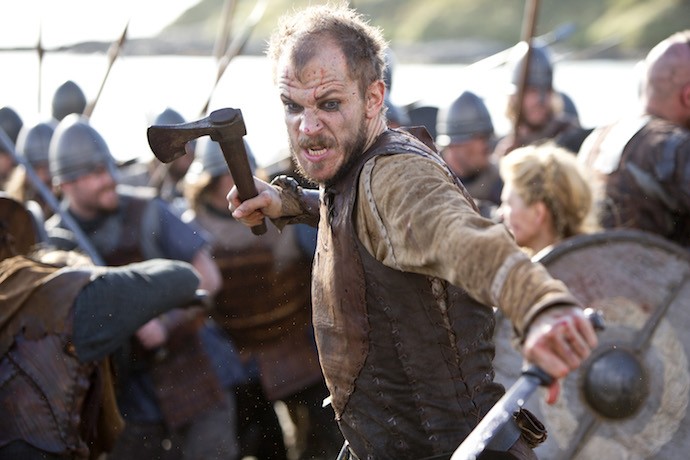History Channel’s Vikings is back for Season 4, as committed as ever to a balanced portrayal of a much maligned “Other” that’s been reliably portrayed as über-violent heathens in everything from movies like Valhalla Rising to video games like War of the Vikings. To be sure, there are plenty of scenes with bearded barbarians sinking their battle axes into the skulls of cowering Christians, but the warriors of the lands that would become England and France appear no less brutal in their defense of Christendom.
In one scene, the Christian Prince Aethelwulf, who earlier in the series said that “it is just not possible to imagine a world in which there is both one god and several,” unleashed genocidal fury on a settlement of unarmed, pagan, Viking farmers who had been promised protection by the king. Yet, the show includes vestiges of the violent heathen trope that’s been a staple of how dominant religious groups have portrayed minority religious groups throughout history.
In one particularly grisly scene, the protagonist Ragnar Lothbrok performs the notorious “blood eagle” ritual on his recently-conquered enemy, after which the tortured victim is said to resemble an eagle with outspread wings (warning: NSFW). To emphasize the bottomless cruelty of the act, it was said that the victim who cries out in pain during the execution will be denied entrance into Valhalla.
Despite the fact that the gruesome nature of the blood eagle has been noted in numerous literary and historical depictions of the Vikings there’s no evidence that the practice ever took place.
It comes from a misinterpretation of an Icelandic poem from the eleventh century. In one passage it states, “And Ivar, he who resided in York, caused the eagle to cut on [King] Ella’s back.” Anders Winroth, in his book The Age of the Vikings, notes that the poem more likely refers to scavenger birds tearing at the flesh of the unburied corpses of battle-slain enemies rather than a ritual of torture.
Misunderstandings of the blood eagle emerged in the centuries following the Viking raids on Christian Europe. The English priest-historian Henry of Huntingdon described the Vikings who had invaded his country as exceedingly “monstrous and cruel” pursuing violence and destruction for its own sake. Christian Scandinavian writers of the thirteenth century also emphasized the savagery of their pagan ancestors and they were quite eager to imaginatively interpret the poetic reference to the blood eagle as a particularly savage method of execution. Accusations that pagan Vikings were exceptionally violent have long been used to bolster Christian martyrdom narratives and emphasize the civilizing impact that Christianity had on a formerly-barbaric Scandinavia.
Majority religious groups have often accused minority groups of engaging in barbaric practices. Portrayals of conquered groups as savage are typically paralleled by claims that the dominant group is morally superior, and therefore, justified in its conquest of the other. Folklorist Alan Dundes used the term “projective inversion” to describe the process by which dominant groups accuse subordinate groups of savagery and recast themselves as victims.
Blood libel is a classic example. Many Medieval Christians believed that Jews used the blood of Christian children in Jewish rituals and in the baking of Passover matzo. These accusations were often used as a justification for the murder and expulsion of Jews from Christian lands.
Fantasies of savagery can also be found in European American depictions of Native Americans. During the campaigns against the Karankawa Indians, Colonel John Moore of the Texas Rangers argued that the Indians’ cannibalism was “beyond question.” Although he had never observed the practice, and ethnographic accounts of the Karankawa show no evidence, Moore used the myth to justify the massacre of over 40 Karankawa in 1826.
Christians have also been on the receiving end of accusations of savagery. While still an infant movement in imperial Rome, the followers of Jesus were accused of participating in cannibalism, a misunderstanding that arose from the ritual practice of the Eucharist, which includes consuming the body and blood of Christ. Accusations that Christianity represented a threatening, savage “other” served to justify the imprisonment and execution of Christians in the centuries before the minority sect became the official religion of the empire.
The trope of the violent heathen is still used to stoke the flames of xenophobia and to malign minorities. From the supposed “wilding” of teenagers that fed into the false convictions in the Central Park Jogger case, to the more recent “knockout game” scare, racialized myths continue to this day. Joseph Laycock’s book Dangerous Games shows how American youth are frequently cast as violent and threatening because of their participation in role-playing fantasy games such as Dungeons and Dragons. In August of 2014, thousands of Yezidis were murdered in northwestern Iraq by ISIL militants, who accused them of practicing Satan worship. Buddhist militants in Myanmar have justified the burning of mosques by portraying the Muslim Rohingya minority as particularly violent.
Although it’s difficult to imagine the pagan Viking as a vulnerable minority, the characterization of them as the embodiment of rapacious savagery reveals much about the guardians of the religious and cultural system that came to dominate them. The mythological exaggerations among medieval Christian writers about Viking savagery disguised the violence which was perpetrated in the rise of Christendom. Although the Christian emperor Charlemagne is often portrayed as a founding father of Europe, he was notorious for his use of violence; on just one day in 782, he had 4,500 of his Saxon enemies decapitated. As Anders Winroth notes, the actions of the Vikings pale in comparison. Nonetheless, the victors in any cultural conquest, especially the literate ones, get to control the narrative about who is innocent and who is not.
Despite the History channel’s artistic embellishments about the practice of the blood eagle, the show mostly succeeds in demonstrating that Vikings were no more violent than their enemies. It’s perhaps a small step forward the Vikings series portrays the violent heathen not as a brown, racialized other, but as a remnant of a European past imagined to be more violent than the present. On the other hand, the Republican frontrunner Donald Trump, who was among the loudest of those calling for the heads of the wrongly accused teens in the Central Park Jogger case, and who famously called Mexican immigrants rapists, appears to have taken this history as a how-to manual.




